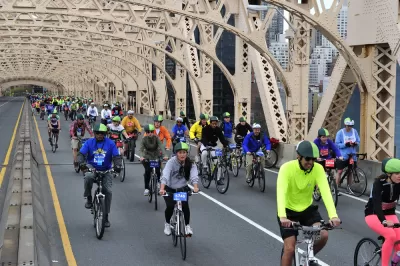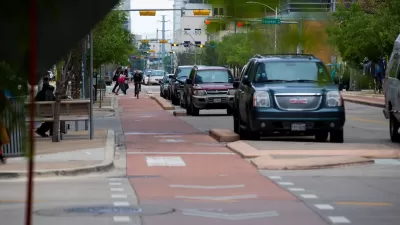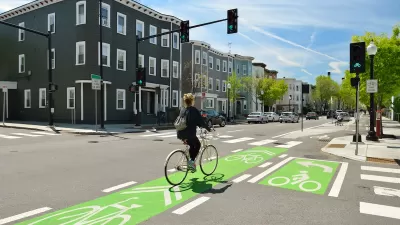Three new bike lanes will help connect the region's bikeway system and improve safety on the city's roads and bridges.

After years of calls from advocates to improve bike safety in Long Island City, New York's Department of Transportation will install bike lanes on three busy corridors, reports Julianne Cuba.
Department of Transportation officials on Tuesday night unveiled their plans for the new safety infrastructure on 44th Drive, 11th Street, and Jackson Avenue, amid a citywide bike boom that’s echoing particularly loudly in Long Island City. Cyclists are now taking more than 6,400 trips across the Queensboro Bridge — which experienced the highest jump of daily riders across the four East River spans — and more than 2,000 trips per day across the Pulaski Bridge, according to DOT.
According to the article, "The work is part of former Mayor de Blasio ‘s Green Wave plan that was announced during the summer of 2019, a year when a total of 29 cyclists were killed on city streets."
"Left out of the proposal are improvements to Borden Avenue and the intersection at the foot of the Pulaski Bridge, which Shepard says is treacherous for cyclists and pedestrians alike. DOT did not address that issue of that intersection, where there have been 68 crashes since March, 2017, injuring six cyclists and 11 motorists, according to city stats."
FULL STORY: Long Island City Getting Some Protected Bike Lanes

Trump Administration Could Effectively End Housing Voucher Program
Federal officials are eyeing major cuts to the Section 8 program that helps millions of low-income households pay rent.

Planetizen Federal Action Tracker
A weekly monitor of how Trump’s orders and actions are impacting planners and planning in America.

Ken Jennings Launches Transit Web Series
The Jeopardy champ wants you to ride public transit.

California Invests Additional $5M in Electric School Buses
The state wants to electrify all of its school bus fleets by 2035.

Austin Launches $2M Homelessness Prevention Fund
A new grant program from the city’s Homeless Strategy Office will fund rental assistance and supportive services.

Alabama School Forestry Initiative Brings Trees to Schoolyards
Trees can improve physical and mental health for students and commnity members.
Urban Design for Planners 1: Software Tools
This six-course series explores essential urban design concepts using open source software and equips planners with the tools they need to participate fully in the urban design process.
Planning for Universal Design
Learn the tools for implementing Universal Design in planning regulations.
Ada County Highway District
Clanton & Associates, Inc.
Jessamine County Fiscal Court
Institute for Housing and Urban Development Studies (IHS)
City of Grandview
Harvard GSD Executive Education
Toledo-Lucas County Plan Commissions
Salt Lake City
NYU Wagner Graduate School of Public Service





























